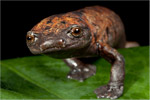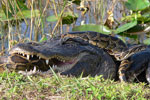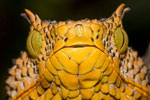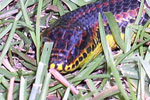-(Large).568.jpg)
World’s rarest snake: Saint Lucia racer. Photo by: G. Guida.
It’s slithery, brown, and doesn’t mind being picked up: meet the Saint Lucia racer (Liophis ornatus), which holds the dubious honor of being the world’s most endangered snake. A five month extensive survey found just 18 animals on a small islet off of the Caribbean Island of Saint Lucia. The snake had once been abundant on Saint Lucia, as well, but was decimated by invasive mongooses.
For nearly 40 years the snake was thought to be extinct until in 1973 a single snake was found on the Maria Major Island, a 12-hectare (30 acre) protected islet, a mile off the coast of Saint Lucia (see map below). After catching and tagging 10 individuals, scientists now believe 18 may survive in total. The island is free of the mongoose that have killed off the population of Saint Lucia. Non-venomous, the Saint Lucia racer feeds on local lizards.
“It was a huge relief to confirm that a population of the racer still survives,” Matthew Morton, Eastern Caribbean Program Manager for the Durrell Wildlife Conservation Trust (DWCT), said in a press release, “but that relief is tempered by the knowledge of how close we still are to losing it forever.”
The DWCT is working with Fauna & Flora International, the Saint Lucia National Trust, and the Saint Lucia Forestry Department to save the species with additional funding support from the Balcombe Trust, the Disney Worldwide Conservation Fund and the U.S. Fish & Wildlife Service.
Conservationists working with the Saint Lucia racer are closely looking at successful efforts to save the Antiguan racer (Alsophis antiguae). With a population that hit a nadir of 50 individuals in 1995, the Antiguan racer today has a population of over 900. Eradicating invasive predators, such as mongoose and rats, as well as education efforts have helped the Antiguan racer bounce back. Researchers are now looking to reintroduce the snake to more habitats as an insurance policy against extinction, especially as climate change raises sea levels.
“Tens if not hundreds of West Indian animals have already been lost because humans have unwisely released harmful species from other parts of the world, and we cannot allow the gentle Saint Lucia racer to be the next casualty” Jenny Daltry, Senior Conservation Biologist with Fauna & Flora International says. “To do nothing is not an option.”
-T-Ross---Durrell.568.jpg)
Stephen Lesmond holding one of the world’s last Saint Lucia racers. Photo by: T. Ross with DWCT.
View Larger Map
Related articles
Herp paradise preserved in Guatemala

(05/29/2012) Fifteen conservation groups have banded together to save around 2,400 hectares (6,000 acres) of primary rainforest in Guatemala, home to a dozen imperiled amphibians as well as the recently discovered Merendon palm pit viper (Bothriechis thalassinus). The new park, dubbed the Sierra Caral Amphibian Reserve, lies in the Guatemalan mountains on the border with Honduras in a region that has been called the most important conservation area in Guatemala.
Scientists discover deadly new sea snake
(02/24/2012) Scientists in Australia have discovered a species of sea snake in estuaries of the Gulf of Carpenteria in northern Australia. The snake is described in the current issue of Zootaxa.
‘Snakes on a Plane’ trafficker freed early from jail
(02/22/2012) Notorious wildlife trafficker Anson Wong has been freed from prison after a court reduced his five-year term, reports Malaysian state media. Wong had served 17-and-a-half-months for illegally exporting nearly 100 reptiles from Malaysia.
Invasion!: Burmese pythons decimate mammals in the Everglades
(01/30/2012) The Everglades in southern Florida has faced myriad environmental impacts from draining for sprawl to the construction of canals, but even as the U.S. government moves slowly on an ambitious plan to restore the massive wetlands a new threat is growing: big snakes from Southeast Asia. A new paper in the Proceedings of the National Academy of Sciences (PNAS) has found evidence of a massive collapse in the native mammal population following the invasion of Burmese pythons (Python molurus bivittatus) in the ecosystem. The research comes just after the U.S. federal government has announced an importation ban on the Burmese python and three other big snakes in an effort to safeguard wildlife in the Everglades. However, the PNAS study finds that a lot of damage has already been done.
U.S. implements snake ban to save native ecosystems

(01/25/2012) Last week the U.S. Fish and Wildlife Service (USFWS) announced it was banning the importation and sale across state lines of four large, non-native snakes: the Burmese python (Python molurus bivittatus), the yellow anaconda (Eunectes notaeus), and two subspecies of the African python (Python sebae). Although popular pets, snakes released and escaped into the wild have caused considerable environmental damage especially in the Florida Everglades.
New large horned viper discovered, but biologists keep location quiet

(12/15/2011) In a remote forest fragment in Tanzania, scientists have made a remarkable discovery: a uniquely-colored horned viper extending over two feet long (643 millimeters) that evolved from its closest relative over two million years ago. Unfortunately, however, the new species—named Matilda’s horned viper (Atheris matildae)—survives in a small degraded habitat and is believed to be Critically Endangered. Given its scarcity, its discoverers are working to pre-empt an insidious threat to new species.
Giant snakes commonly attacked modern hunter-gatherers in Philippines

(12/13/2011) Humans have an ambivalent relationship with snakes. The legless reptiles are often feared and reviled, becoming stand-ins for the Devil and movie monster characters; yet many people have grown to love snakes, raising large, even dangerous, specimens as pets. Now, new research suggests that the ecological role between snakes and humans, as well as other primates, is more nuanced than expected. After spending decades living among the Agta Negritos people in the Philippines, anthropologist Thomas Headland has found that the hunter gatherer tribes were quite commonly attacked by reticulated pythons (Python reticulatus), while the people themselves had no qualms with hunting, killing, and consuming python.
$500 offered for rediscovery of extinct snake

(11/29/2011) Need to make a quick 500 bucks? Easy: head to Glades County, Florida and find a specimen of the South Florida rainbow snake (Farancia erytrogramma seminola), which the US government says is extinct. In an unusual bid two NGOS, the Center for Biological Diversity (CBD) and the Center for Snake Conservation, are offering a substantial reward to the first person who can prove that the South Florida rainbow snake has not vanished forever.